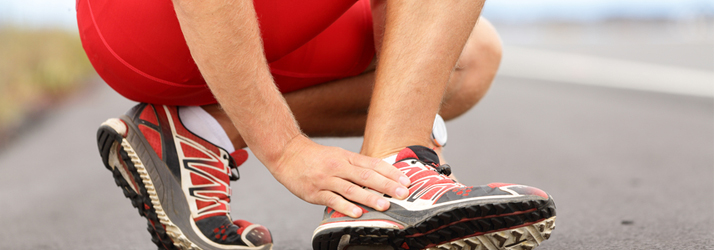What is the difference between a sprain and a strain? Often these words are used interchangeably but they actually mean different things. Joseph lists common causes and symptoms of each type of injury, and provides tips to prevent them. Read more...
Sprains
A sprain is an injury to a ligament or joint capsule. These are parts of the body that join one bone to another and stabilize the joint. A common example is a sprained ankle. There is a ligament on the outside of your ankle that connects the shin to the foot. If you turn your ankle too far to the inside, this ligament can be stretched or even completely torn.
What are the signs of a sprain?
People often feel a tear or pop when the injury happens, but not always.
Strains
A strain is an injury to the muscle or tendon that connects the muscle to the bone. Two common sites for a strain are the back and the hamstring muscle in the back of the thigh. As with sprains, these injuries can range from a mild stretching of the muscle/tendon to a complete tear.
What are the signs of a strain?
Sprains are usually caused by a sudden event that knocks the joint out of position, such as falling, twisting, or getting hit. They often occur when people:
Inadequate rest or increasing an exercise too quickly can cause connective tissue to break down. This is especially true for tendons, as they are not as strong as muscles and do not receive as much blood flow to allow for recovery. Sometimes, while your muscles may feel fine, the tendon is still recuperating. This is why it is so important to adequately rest between exercises.
Treatment
Initially, an injury should be treated with P.R.I.C.E - Protection, Rest, Ice, Compression, and Elevation. This can help decrease pain and prevent further damage. For all but mild cases, see your healthcare professional to establish a treatment plan. Mild sprains and strains can usually be treated by temporarily modifying your daily activities and engaging in the proper rehabilitation exercises. A severe sprain or strain may require surgery, followed by prolonged therapy.
Prevention Tips
Here are some tips developed by the American Academy of Orthopedic Surgeons to help reduce your injury risk:
A sprain is an injury to a ligament or joint capsule. These are parts of the body that join one bone to another and stabilize the joint. A common example is a sprained ankle. There is a ligament on the outside of your ankle that connects the shin to the foot. If you turn your ankle too far to the inside, this ligament can be stretched or even completely torn.
What are the signs of a sprain?
- Pain
- Swelling
- Bruising
- Inflammation
People often feel a tear or pop when the injury happens, but not always.
Strains
A strain is an injury to the muscle or tendon that connects the muscle to the bone. Two common sites for a strain are the back and the hamstring muscle in the back of the thigh. As with sprains, these injuries can range from a mild stretching of the muscle/tendon to a complete tear.
What are the signs of a strain?
- Pain
- Muscle spasms
- Muscle weakness
- Swelling
- Inflammation
- Cramping
Sprains are usually caused by a sudden event that knocks the joint out of position, such as falling, twisting, or getting hit. They often occur when people:
- Fall on the side of their foot
- Fall and land on an outstretched arm
- Twist a knee
- Lifting heavy objects the wrong way
- A direct blow to the body
- Over-stressing the muscles
Inadequate rest or increasing an exercise too quickly can cause connective tissue to break down. This is especially true for tendons, as they are not as strong as muscles and do not receive as much blood flow to allow for recovery. Sometimes, while your muscles may feel fine, the tendon is still recuperating. This is why it is so important to adequately rest between exercises.
Treatment
Initially, an injury should be treated with P.R.I.C.E - Protection, Rest, Ice, Compression, and Elevation. This can help decrease pain and prevent further damage. For all but mild cases, see your healthcare professional to establish a treatment plan. Mild sprains and strains can usually be treated by temporarily modifying your daily activities and engaging in the proper rehabilitation exercises. A severe sprain or strain may require surgery, followed by prolonged therapy.
Prevention Tips
Here are some tips developed by the American Academy of Orthopedic Surgeons to help reduce your injury risk:
- Participate in a conditioning program to build muscle strength
- Do stretching exercises daily
- Always wear properly fitting shoes
- Nourish your muscles by eating a well-balanced diet
- Warm up before any sports activity, including practice
- Use or wear protective equipment appropriate for that sport




